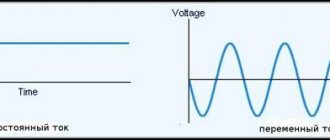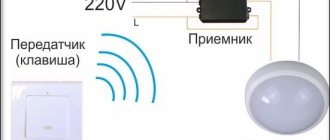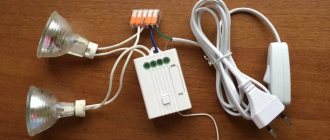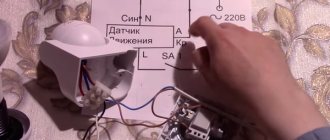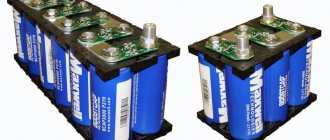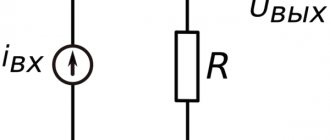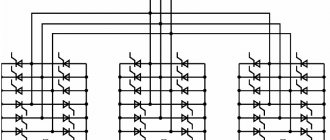Electrothermal Thomson effect.
In 1854, W. Thomson (Kelvin) discovered that if a metal conductor is heated at one point and an electric current is simultaneously passed through it, then a temperature difference arises at the ends of the conductor equidistant from the heating point (Fig. 4). At the end where the current is directed towards the heating point, the temperature decreases, and at the other end, where the current is directed away from the heating point, it increases. The Thomson coefficient is the only thermoelectric coefficient that can be measured on a homogeneous conductor. Thomson later showed that all three phenomena of thermoelectricity are related to each other by the Kelvin relations already mentioned above.
Accuracy and speed of measurements
The size of the operating error of thermoelements depends on the structure, properties of the alloys, operating conditions and operating environment.
Reasons for inaccuracies:
- heterogeneity of insulation (chemical, presence of inclusions, sagging, internal stresses);
- deformation of electrode elements during manufacturing and operation.
Based on the speed of response to voltage, there are different types of thermocouples:
- high inertia - 210 seconds;
- medium inertia - up to 60 seconds;
- small - up to 40 seconds.
Electrothermal Peltier effect.
In 1834, the French watchmaker J. Peltier noticed that when current passes through a junction of two different conductors, the temperature of the junction changes. Like Seebeck, Peltier did not at first see an electrothermal effect in this. But in 1838 E.H. Lenz, a member of the St. Petersburg Academy of Sciences, showed that with a sufficiently large current, a drop of water applied to a junction can either be frozen or brought to a boil by changing the direction of the current. With one direction of current, the junction heats up, and with the opposite direction, it cools. This is the Peltier effect (Fig. 3), the opposite of the Seebeck effect.
How to check functionality
Use a voltmeter or multimeter , which is set to mV. At the connection, remove the nut that presses the thermocouple to the solenoid valve socket, and remove the working device of the converter. The working area of the couple is heated so that voltage arises in it. When heated, the flame envelops the conductors; a candle or gas burner fire is suitable for this.
Keep in the flame for 30 - 50 seconds , then the first probe of the tester is applied to the thermocouple box, the second to the output contact. Measure for 40 - 60 seconds, without ceasing to heat the working solder. A working element produces a voltage above 20 mV or 0.02 V , some samples show 50 - 55 mV. If the readings are within these limits, the thermocouple is suitable for use.
Areas of application of thermoelectric products
Currently, thermoelectric modules are actively used in such high-tech fields as telecommunications, space, precision weapons, medicine, etc. The construction of modern laser, optical, and electronic systems is unthinkable without the use of cooling and temperature-controlled systems based on thermoelectric modules. Thermoelectric modules are also actively used in household appliances: portable refrigerators, freezers, coolers for drinking water and drinks, compact air conditioners, etc.
The main areas of application of thermoelectric modules and systems based on them:
- Radio electronics - miniature coolers for various electronic devices
- Medicine - mobile cooling containers, medical instruments and equipment
- Scientific and laboratory equipment
- Consumer Products - Portable refrigerators, drinking water coolers and other devices
- Air conditioning devices - thermoelectric air conditioners for various purposes, devices for stabilizing the temperature of electronic equipment units, etc.
The use of TEM in electricity generation has broad prospects.
The thermoelectric generator allows you to directly generate electricity from any heat source. The advantage of a thermoelectric generator is the absence of rotating, rubbing and other wear parts.
Regional offices
Contacts
Regional offices
Contacts
Regional offices
Contacts
Regional offices
Contacts
RECOMMENDATIONS To fully implement the technical characteristics of our products and guarantee their long-term operation, we kindly ask you to carefully read the product parameters and recommendations for its use when choosing a thermoelectric solution.
Online ordering of products in stock from the website
HOW TO ORDER
You can order products in stock from the website online; after placing your order, you will be sent an invoice for payment.
PAYMENT
Products are delivered on the basis of 100% prepayment by bank transfer; payment must be made in accordance with the commercial invoice sent to you. Products are reserved for your order for 5 working days while you wait for payment.
DEADLINES
Your order will be ready for shipment within no more than 10 business days from the date payment is received in our bank account.
DELIVERY
The delivery cost is determined at the checkout stage in the shopping cart and is calculated depending on the delivery service and the selected delivery region.
Types of thermocouples
The International European Standard provides tables and characteristics for electric thermocouples made of various combinations of metals. In Russia, similar standards have not yet been developed.
According to the method of operation, there are varieties:
- measuring by immersion;
- working superficially.
Thermoelements are manufactured without a casing, with steel, heat-resistant, porcelain covers, with insulation made of refractory metal.
Thermal devices are distinguished by design:
- with movable and fixed fitting and flange,
- with a regular, waterproof head;
- with termination of leads without a head.
They produce thermoelements protected and unprotected from aggressive environments. There are varieties that operate under high pressure and are non-sealed, resistant to vibration, shock, and simple.
Chromel-alumel (TCA)
A common option used in industry (furnaces, heaters) and scientific activities (in laboratory instruments). The temperature meter operates in acidic and inert conditions, used for coordination in vacuum space (for a short time) and in dry hydrogen gas.
characteristics :
- long-term determines temperature indicators up to +1100°C, simultaneously - +1300°C;
- used to determine low values (up to -200°C);
- sensitivity about 40 µV/°C;
- used in reactors for irradiation.
The disadvantage is the strong sensitivity to mechanical deformation of the electrodes and the instability of thermo-EMF, which is reversible.
The positive electrode is made of chromel, the negative - alumel.
Chromel-copel (TCC)
The most sensitive thermocouples, their value exceeds 81 µV/°C at temperatures greater than +200°C. The meter has high thermal stability.
Features of the Chromel-Kopel thermocouple:
- measures indicators in acidic and inert environments;
- Operated at a temperature of +800°C continuously, used for a short time at +1100°C;
- the lower limit is -253°C.
It shows the greatest stability at values not exceeding +600°C. Thermocouples are often used in scientific laboratories, and thermocouples are successful at measuring small differences in temperature.
Iron-constatan (ILC)
They are used in industry in reducing and oxidizing environments, vacuum, and are recommended for coordinating simultaneously negative and positive temperatures.
Properties of the iron-constatan thermocouple:
- measures values in the range -203° - +1100°C (short-term), +750°C (long-term);
- not used to control only negative temperatures;
- sensitivity - at the level of 50 - 65 µV/°C.
The disadvantage is that the thermocouple shows incorrect values when the conductors are deformed. Iron electrodes have low resistance to corrosion.
The material of positive thermoelements is low-carbon iron, and the material of negative thermoelements is constantan (an alloy of nickel and copper).
Tungsten-rhenium (TVR)
The thermoelement is recognized as the best option for industrial use at temperatures above +1800°C .
Works in helium, hydrogen, nitrogen environment or without gases (in vacuum). They have proven themselves well under high heat and sudden temperature changes. Characteristics of tungsten-rhenium pairs:
- measure indicators in the range -1300° - +3000°C;
- thermal EMF - within 22 - 34 mV for electrodes made of various alloys;
- sensitivity 4 – 10 µV/°C.
The elements are durable, successfully cope with alternating loads, and do not become dirty. The disadvantage is sensitivity to radiation, its decrease at levels above +2400°C.
Tungsten-molybdenum (TMM)
Measurements are carried out in a vacuum, hydrogen or inert environment without oxidizing impurities. The thermocouple is cheaper than all other thermal sensor options for detecting high temperatures.
Features of the tungsten-molybdenum pair:
- constantly works at -1400° - +1800°C, briefly used at +2400°C;
- sensitivity - 6.5 µV/°C in these temperature ranges.
Durable thermoelectrodes are inert to chemical attack.
Disadvantage: weak reproduction of thermo-emf, polarity inversion. With strong, prolonged heating, brittleness occurs as oxidation occurs.
With ceramic protection of the electrodes and the presence of caps, it functions in an acidic environment and liquid metals.
Platinorhodium-platinum (TPP)
Thermocouples are made from an alloy of platinum with rhodium (10 or 13%) and platinum. Used for control under inert and acidic conditions. Characterized by accurate values, high reproducibility and constant thermo-EMF.
Properties of the PP thermocouple:
- The operating temperature of continuous measurements is -600° - +1400°C, used for a short time at +1600°C;
- show sensitivity at 10 – 12 µV/°C at 10% rhodium, 11 – 14 µV/°C (13%).
The disadvantages are the variability of accuracy at a high degree of irradiation; in addition, such elements are expensive. Thermocouples must be protected from metal and chemical dirt during manufacture and operation.
Platinorhodium-platinumrhodium (PPR)
The thermocouple is used to find the temperature in a neutral and acidic environment, as well as in a vacuum. The pair is mounted without long conductors because it has low sensitivity at 0° - 100°C.
Features and characteristics of thermocouple PR:
- works when heated to +1600°C (continuously), up to +1800°C (short-term);
- sensitivity 10.5 – 11.5 µV/°C at readings above +1200°C.
The thermoelement shows greater strength and stability at high temperatures; the electrodes are not subject to graininess, brittleness during temperature changes, and are not prone to the accumulation of dirt on the surface. They are used in glass melting, cement making, metallurgy, and the production of refractory materials.
Connection diagram
For remote connections, compensation and extension wires are used. The latter choose the same material as the thermocouple electrodes, but a different diameter is allowed. Compensation ones, on the contrary, are made from alloys with opposite properties.
Thermal meters are connected using two methods :
- simple - the converter is connected directly to the electrodes;
- differential - use 2 conductors with different emfs, welded at the ends, while the converter is placed in the gap of one conductor.
Mounted so that there is no spatial tension of the conductors and vibration.


